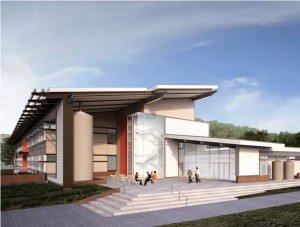
Architect\’s image of new Mathias Lab, complete with rain cistern on porch and wetlands to the left. (Credit: EwingCole)
Sustainable houses and office buildings have seen their popularity surge in recent years. But creating a more sustainable laboratory, especially one with chemistry research, where fume hoods can consume up to three times as much energy as an average home, is a bit more of a challenge.
On May 6, SERC broke ground for a new Mathias Lab with its own solar, geothermal and water recycling systems. Analysts estimate it will consume at least 37 percent less energy, and emit 37 percent less carbon dioxide, than a similar building that meets only the bare minimum requirements for LEED certification – the standard for green building. SERC staff are targeting LEED gold.
The old lab isn’t disappearing. The 21,000 feet of current lab space will undergo massive remodeling, while builders tack on 69,000 square feet of new lab, office and support space. A two-story atrium will connect the old and new sections and create a space where scientists from different departments can share ideas.
Because SERC scientists specialize in a multitude of disciplines – including global change, nutrient pollution and invasive species – having that interconnected space is critical for collaboration. The new lab will divide research into four research “guilds”: marine/estuarine and terrestrial ecology on the first floor, and environmental chemistry and cell/photo/molecular ecology on the second.
To leave a greener footprint, the new laboratory will include:
- An HVAC system supplied by a large geothermal well field (250 wells 430 feet deep)
- A 350-kilowatt array of solar panels on the renovated section to provide almost 14 percent of the building’s electricity
- Constructed wetland made of a series of cascading pools lined with native plants, to help with stormwater management and runoff
- A system to reclaim wastewater by cleaning it at an outside treatment plant and re-using it in toilets, gardens, fire suppression and the constructed wetland
- Low-flow fume hoods for chemistry experiments
- High-efficiency enthalpy wheels that recover energy from exchanged air
- Bicycle racks and priority parking for carpools and high-efficiency vehicles
- Solar panel recharging stations for electric vehicles
-by Kristen Minogue
Read More: Mathias Lab opens its doors


No mention of the building envelope, one of the greatest and most often overlooked areas to generate energy savings. Maybe it is because the widely used energy modeling programs that designers use to plan these buildings do not differentiate between insulated thermal mass(good) and isolated thermal mass (not so good).
Is this yet another wasted opportunity that will last for many years?
650 solar panels makes roughly 12,916 square feet for the entire building (assuming they are placed on the roof).
Thats pretty large for only 10% of the building electricity, or am I missing something?
Now that is is 6 months since the building went up – I wonder if they have validated the estimates of electricity reduction.
Would be interesting to see/hear – do you have any follow up?
This is a very interesting post , I have never even heard of High-efficiency enthalpy wheels before.I better get googling and see what they are ;0
cheers
This is an interesting building, although I am always skeptical about buildings that claim to have a “greener footprint” because some of these measures don’t take into consideration the fact that they have a negative impact on the ecosystems of the surrounding environment.
I guess at some point you just have to choose your battles and plow ahead.
Having a lab with its own solar, geothermal and water recycling systems is amazing. There is a need to have the new buildings, whether offices, hotels or science labs, echo friendly. This is great move to drive the world towards echo friendly constructions. Save nature, it will save us!
I am constantly suspicious about structures that claim to have a “greener foot shaped impression” in light of the fact that some of these measures don’t contemplate the way that they have a negative effect on the biological systems of the encompassing environment